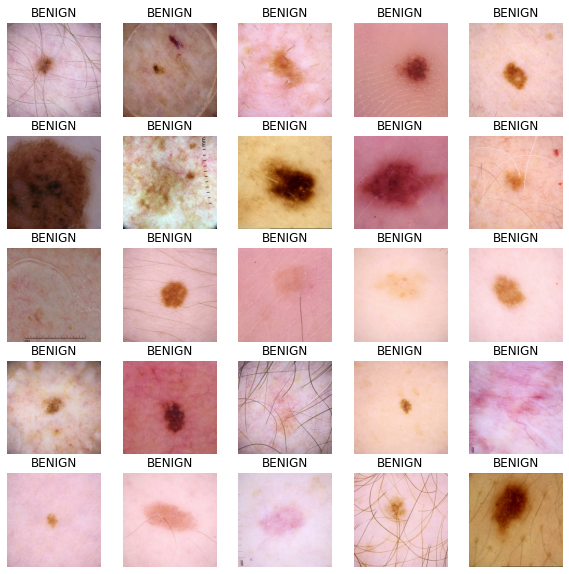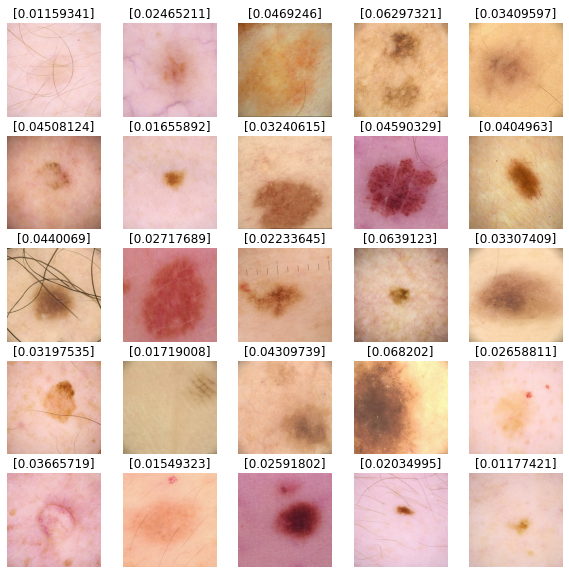无
如何使用 TFRecord 文件训练 Keras 模型
作者: Amy MiHyun Jang
创建日期 2020/07/29
最后修改日期 2020/08/07
描述: 加载 TFRecords 以用于计算机视觉模型。
引言 + 设置
TFRecords 存储一系列二进制记录,按顺序读取。它们因可以高效读取而成为存储数据的有用格式。在此 处 详细了解 TFRecords。
我们将探索如何轻松加载 TFRecords 以用于我们的黑色素瘤分类器。
import tensorflow as tf
from functools import partial
import matplotlib.pyplot as plt
try:
tpu = tf.distribute.cluster_resolver.TPUClusterResolver.connect()
print("Device:", tpu.master())
strategy = tf.distribute.TPUStrategy(tpu)
except:
strategy = tf.distribute.get_strategy()
print("Number of replicas:", strategy.num_replicas_in_sync)
Number of replicas: 8
由于我们的数据不平衡,我们希望更大的批次大小。
AUTOTUNE = tf.data.AUTOTUNE
GCS_PATH = "gs://kds-b38ce1b823c3ae623f5691483dbaa0f0363f04b0d6a90b63cf69946e"
BATCH_SIZE = 64
IMAGE_SIZE = [1024, 1024]
加载数据
FILENAMES = tf.io.gfile.glob(GCS_PATH + "/tfrecords/train*.tfrec")
split_ind = int(0.9 * len(FILENAMES))
TRAINING_FILENAMES, VALID_FILENAMES = FILENAMES[:split_ind], FILENAMES[split_ind:]
TEST_FILENAMES = tf.io.gfile.glob(GCS_PATH + "/tfrecords/test*.tfrec")
print("Train TFRecord Files:", len(TRAINING_FILENAMES))
print("Validation TFRecord Files:", len(VALID_FILENAMES))
print("Test TFRecord Files:", len(TEST_FILENAMES))
Train TFRecord Files: 14
Validation TFRecord Files: 2
Test TFRecord Files: 16
解码数据
图像必须转换为张量,才能成为我们模型的有效输入。由于图像使用 RGB 比例,因此我们指定 3 个通道。
我们还重塑了数据,以便所有图像都具有相同的形状。
def decode_image(image):
image = tf.image.decode_jpeg(image, channels=3)
image = tf.cast(image, tf.float32)
image = tf.reshape(image, [*IMAGE_SIZE, 3])
return image
在加载数据时,我们需要 X 和 Y。X 是我们的图像;模型将在我们的图像数据集中找到特征和模式。我们想预测 Y,即图像中的病灶是恶性的概率。我们将遍历 TFRecords 并解析出图像和目标值。
def read_tfrecord(example, labeled):
tfrecord_format = (
{
"image": tf.io.FixedLenFeature([], tf.string),
"target": tf.io.FixedLenFeature([], tf.int64),
}
if labeled
else {"image": tf.io.FixedLenFeature([], tf.string),}
)
example = tf.io.parse_single_example(example, tfrecord_format)
image = decode_image(example["image"])
if labeled:
label = tf.cast(example["target"], tf.int32)
return image, label
return image
定义加载方法
我们的数据集没有有意义的顺序,因此在加载数据集时可以忽略顺序。通过忽略顺序并尽快读取文件,可以缩短加载数据所需的时间。
def load_dataset(filenames, labeled=True):
ignore_order = tf.data.Options()
ignore_order.experimental_deterministic = False # disable order, increase speed
dataset = tf.data.TFRecordDataset(
filenames
) # automatically interleaves reads from multiple files
dataset = dataset.with_options(
ignore_order
) # uses data as soon as it streams in, rather than in its original order
dataset = dataset.map(
partial(read_tfrecord, labeled=labeled), num_parallel_calls=AUTOTUNE
)
# returns a dataset of (image, label) pairs if labeled=True or just images if labeled=False
return dataset
我们定义了以下函数来获取不同的数据集。
def get_dataset(filenames, labeled=True):
dataset = load_dataset(filenames, labeled=labeled)
dataset = dataset.shuffle(2048)
dataset = dataset.prefetch(buffer_size=AUTOTUNE)
dataset = dataset.batch(BATCH_SIZE)
return dataset
可视化输入图像
train_dataset = get_dataset(TRAINING_FILENAMES)
valid_dataset = get_dataset(VALID_FILENAMES)
test_dataset = get_dataset(TEST_FILENAMES, labeled=False)
image_batch, label_batch = next(iter(train_dataset))
def show_batch(image_batch, label_batch):
plt.figure(figsize=(10, 10))
for n in range(25):
ax = plt.subplot(5, 5, n + 1)
plt.imshow(image_batch[n] / 255.0)
if label_batch[n]:
plt.title("MALIGNANT")
else:
plt.title("BENIGN")
plt.axis("off")
show_batch(image_batch.numpy(), label_batch.numpy())

构建我们的模型
定义回调函数
以下函数允许模型在每个 epoch 运行时更改学习率。
我们可以使用回调函数在模型没有改进时停止训练。在训练过程结束时,模型将恢复其最佳迭代的权重。
initial_learning_rate = 0.01
lr_schedule = tf.keras.optimizers.schedules.ExponentialDecay(
initial_learning_rate, decay_steps=20, decay_rate=0.96, staircase=True
)
checkpoint_cb = tf.keras.callbacks.ModelCheckpoint(
"melanoma_model.h5", save_best_only=True
)
early_stopping_cb = tf.keras.callbacks.EarlyStopping(
patience=10, restore_best_weights=True
)
构建我们的基础模型
迁移学习是获得经过良好训练的模型带来的好处,而无需自己训练模型的好方法。在此笔记本中,我们想导入 Xception 模型。有关迁移学习的更深入分析,请在此 处 查看。
由于我们的数据不平衡,我们不希望使用 accuracy 作为我们的指标。在我们的示例中,我们将关注 ROC 曲线下的面积。
def make_model():
base_model = tf.keras.applications.Xception(
input_shape=(*IMAGE_SIZE, 3), include_top=False, weights="imagenet"
)
base_model.trainable = False
inputs = tf.keras.layers.Input([*IMAGE_SIZE, 3])
x = tf.keras.applications.xception.preprocess_input(inputs)
x = base_model(x)
x = tf.keras.layers.GlobalAveragePooling2D()(x)
x = tf.keras.layers.Dense(8, activation="relu")(x)
x = tf.keras.layers.Dropout(0.7)(x)
outputs = tf.keras.layers.Dense(1, activation="sigmoid")(x)
model = tf.keras.Model(inputs=inputs, outputs=outputs)
model.compile(
optimizer=tf.keras.optimizers.Adam(learning_rate=lr_schedule),
loss="binary_crossentropy",
metrics=tf.keras.metrics.AUC(name="auc"),
)
return model
训练模型
with strategy.scope():
model = make_model()
history = model.fit(
train_dataset,
epochs=2,
validation_data=valid_dataset,
callbacks=[checkpoint_cb, early_stopping_cb],
)
Downloading data from https://storage.googleapis.com/tensorflow/keras-applications/xception/xception_weights_tf_dim_ordering_tf_kernels_notop.h5
83689472/83683744 [==============================] - 3s 0us/step
Epoch 1/2
454/454 [==============================] - 525s 1s/step - loss: 0.1895 - auc: 0.5841 - val_loss: 0.0825 - val_auc: 0.8109
Epoch 2/2
454/454 [==============================] - 118s 260ms/step - loss: 0.1063 - auc: 0.5994 - val_loss: 0.0861 - val_auc: 0.8336
预测结果
我们将使用我们的模型为测试数据集图像预测结果。值更接近 0 的更可能是良性的,值更接近 1 的更可能是恶性的。
def show_batch_predictions(image_batch):
plt.figure(figsize=(10, 10))
for n in range(25):
ax = plt.subplot(5, 5, n + 1)
plt.imshow(image_batch[n] / 255.0)
img_array = tf.expand_dims(image_batch[n], axis=0)
plt.title(model.predict(img_array)[0])
plt.axis("off")
image_batch = next(iter(test_dataset))
show_batch_predictions(image_batch)
